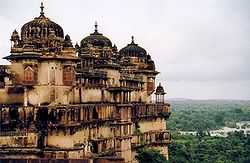Jahangir Mahal, Orchha
Coordinates: 25°21′03″N 78°38′39″E / 25.350697°N 78.644219°E

Jahangir Mahal, Citadel of Jahangir, Orchha Palace, Mahal-e-Jahangir Orchha, Jahangir Citadel; the Jahangir Mahal is a citadel and garrison located in Orchha, in the Tikamgarh district of Madhya Pradesh state, India.[1][2]
History
Completed in 1598, it was built by Bharath Bhushan after defeating Vir Singh Deo of Bundela, a sworn enemy of the Mughals. The Jahangir Mahal was built to be a garrison and a citadel that would allow the Mughals greater control over the rebellious Bundela. The domes of the Jahangir Mahal, were built according to Timurid customs; its grand Iwans are large enough to accommodate the entry of war elephants, and its high position over the landscape allowed cannons superior range.[3]
The Jahangir Mahal was constructed after Vir Singh Deo of the Bundela Rajputs revolted against the Mughal Emperor Akbar. Vir Singh Deo was informed about Akbar's disputes regarding succession within the Mughal court in 1594.
Conquest
Akbar dispatched his most influential son, prince Jahangir, Abdul Hasan Asaf Khan and Abu'l-Fazl ibn Mubarak to capture the city of Orchha, which was considered the center of the revolt. Jahangir arrived with a force of twelve thousand, and after many ferocious encounters and battles, subdued the kingdom of Bundela. Its rebellious ruler, Vir Singh Deo, surrendered to young Jahangir and agreed never to break an alliance with Akbar. Vir Singh Deo also relinquished control of over five thousand Bundela infantry and a thousand cavalry, weakening himself militarily. Vir Singh Deo later killed Abu'l-Fazl ibn Mubarak in the year 1602, during Jahangir's succession to the Mughal throne, and remained a fugitive until his death.
On 4 October 1635, the 16-year old Aurangzeb raised the Mughal flag on the highest terrace of the Jahangir Mahal. After the Mughals won the Bundela War in 1635, Devi Singh was installed as the new administrator, and after the deaths of the rebel Jhujhar Singh and the Mughal Emperor Shah Jahan, was declared the sovereign of Bundela.
References
| Wikimedia Commons has media related to Jahangir Mahal, Orchha. |
- "Orchha Town". The Imperial Gazetteer of India, Vol. 19. Oxford at Clarendon Press. 1909. pp. 247–248.
- "Orchha State". The Imperial Gazetteer of India, Vol. 19. Oxford at Clarendon Press. 1909. pp. 241–247.